There is a more readable version of this review here: HERE
And the Whore is this Temple
An anthology edited by Damian Murphy & Geticus Polus
MOUNT ABRAXAS, Bucharest MMXVI
All the artwork by David Herrerias
Fiction work by John Howard, Alcebiades Diniz Miguel, Thomas Strømsholt, Avalon Brantley, Leopold Nacht, Stephan Friedman, Thomas Phillips, Colin Insole, Rhys Hughes, Andrew Condous, Charles Schneider, Jonathan Wood, Adam S. Cantwell, D.P. Watt.
This tome needs to be seen and handled in real life so as to be believed.
My previous reviews of nearly one hundred of this publisher’s books are linked from HERE.
I intend to real-time review this book during October and my comments will appear in the thought stream below…

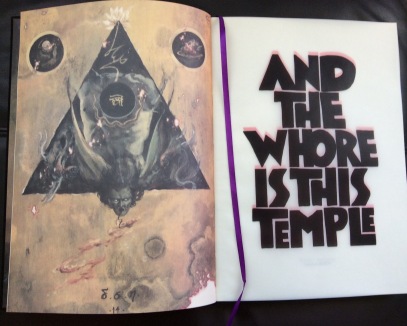
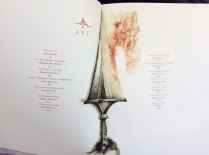

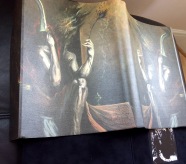
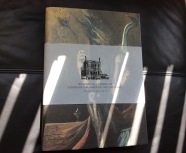
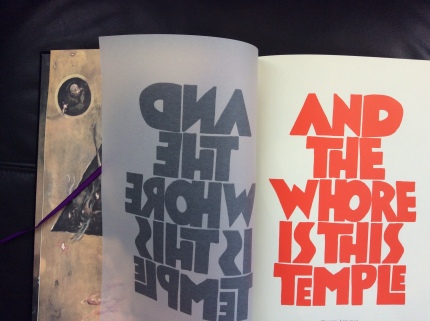
There is no way I can do justice to the great size by weight, volume, ornamental accoutrements, and width-height, its heavy-duty sturdiness, osmotic subtlety, hold-your-breath luxuriance and striking artistic generosity of this book’s physical existence; so you will need to handle it yourself and, even then, other non-textual auras will continue evolving…
And I am also due to be unable to give justice to the authors’ various works, as these texts’ machinations will – by dint of what I pre-imagine their very nature to be – accrue exponentially in any worthy reader’s mind. But here goes …. and I intend to eke out the real-time pleasure of this book as long and as far as possible – perhaps even into the realms of death itself?
The nemonymous preface tells you all about the things that I can’t begin to tell you about the Temple, ending with “The Godhead awaits its pilgrim!”
Followed firstly by….
———————–
ANOTHER SEA by John Howard
“…he didn’t realise how mighty, how interconnected everything truly was. He was a child sitting on a petrol pump with his eyes shut, and striking matches.”
And I feel like that immature child myself, tackling this story. Or I am the old friend brought in at the end with amber lenses… This, for me, is another version of Brexit in a wider sense within Europe, here being its Baltic states transmuted by name and geomantic position, in all its historic-Hanseatic and religious aspects, schisms, heresies and hopes, and despairs. It is a mighty work, one that will take you by the scruffs and sleeves of the land-mass soul.
Beautifully couched. Substantive with “the mingling of awe, wonder, love, terror and sheer invigorating fright that he wished, somehow, to communicate as a believer in the real religion of our communities.”
“This blessed Heaven, this immense jungle, a natural cathedral made by God, would resound with the cry of the damned and the laughter of the saved.”
Three sins, threes signs, three trigonometrical sines from its “geometrical hills” (wherein the sacred books are kept, so think the natives), and thus here we reach the Temple, I guess, of colonisation (bodily and spiritually, even medically?) in this New World, evocatively, often gruesomely, conveyed by the ‘sin’ or point of view of the settler Nunes witnessing the Jesuit priests and the cannibalistic natives, then of a native himself, named Ant, and his friends Worm and Viper, and finally of one of the actual Jesuit Priests, his ‘sin’ made up of two poles and a hidden layer….
I learnt a lot by means of this striking text about such a scenario from history as well as tantamount to FELT the trenchant scourging that the words described on behalf of — as well as applied to — the reader.
“And that ghastly long right limb… Mela disliked him greatly and was a little ashamed of her disgust. The rest of the audience, though, cheered him on.”
Mela has left the apartment and her partner to visit a city kiosk for cigarettes, a strangely foreign place hard to define, but one with suffocating churches, a ruined temple, and aromatic smells from (ironically in view of her otherwise mundane quest) smokes with a mind-punch… she is befriended by a woman who takes her to this story’s own offering as a ‘temple’ with such smokes and censers – and a stage show with that long lop-legged puppet…
And one appreciates fully – with some redolent strength arising from the words like meaning-smoke – the diverse nature of being both a captive and captivated, a diverseness slowly drawing you into blended aspects of those words. As if this book itself is its own temple that has you as unwilling captive and also as a willing subject of captivation. Mela was, you see, both inside the depicted stage show, as well as outside it. A bit like some religions themselves. Like some books that are more than the words that write them.
[O Altítudo]
“I come to a kind of frail, broken state of consciousness, finding myself lost in a forest unlike any I have ever known.”
This has felt to be a huge subliminal and physically weirdtongue-occult type of Biblicality, a rebuilding of a somatic Temple of the author’s life on the pages of this book and interdependent artistic designs, converting such an edifice over a shorter period of précis, but paradoxically now making it eternal by inferred gestalt meaning by means of all of its so-called readers’ minds after absorbing it through a process that combines a knack of inspired reading and assumed cosmic osmosis.
With huge respect, I am treating this work as still within my reader’s collectivisable mind in contrast to how I once treated Finnegans Wake as spilled wantonly outside of my mind HERE.
Pages 75 – 79
“Rather than decorate a canvas or the pages of a book, he had determined to impose his work upon the building in which he lived.”
In the 1971 context of what I take to be a meteorite falling nearby in the Black Forest and a city upon a tributary of the Elbe, we follow, amid a constructively ornate prose, the character of Severin as he wanders this his home city, returning to complete his ‘graffiti’ work in niches and hidden angles within the building where his apartment is situated. But more than just graffiti. That is insulting on my part, judging by the description of his work. Just as my pencilled marks inside this treasure of a book are not really a marginalia of notes but a relishable source for the growing gestalt of this real-time review.
“The motifs that so obsessed him were bound to one another by subtle and indefinable threads.”
I will not cover all the motifs in this stunning work that aches to be eked out sitting by sitting – stunning, for me, at least, who can relate strongly to Severin, particularly his ‘doodling’ at work! – (graffiti, doodles, these are the WRONG words for what he does but I have a mischievous slant upon them) – and here, in this sitting, he speculates on the vanished meteor and Poe’s short short with ‘lodestone’ in the title, and his view on tobacco products before smuggling one of his motifs into one of these products and then put back on sale in tobacconist, and his apartment building seeming to start competing with him by leaving open graffiti upon itself in contrast to Severin’s hidden graffiti.
These are mighty pages full of text. No page numbers can do justice to their size, either literally or metaphorically. In many ways – I admit it here for the first time – I am a naive reader and reviewer, even a gullible one. Yet I need no gullibility to be entranced by this rhapsodic tale of Severin whom I contain as I follow his path from speculation of the missing meteor (with brushes against thoughts of “the thunderstone of Ensisheim” and the Holy Grail as a stone (cf John Cowper Powys)) to his discovery of new ‘graffiti’ on his own door and a ritual masque of his own movements as he is called to another apartment for a meeting….
“The contours of her body revealed themselves beneath her clothing like an open book, a slim volume rich in character and mystery. The inverted arch of her ribcage pressed gently against his own…”
“Rudimentary human forms appeared from place to place among the footpaths that abounded in the artwork,…”
Severin looks back at – and later anticipates another – meeting with Magda, blended with his own view of the warehouses from his window and of the ever-growing motifs in a painting he often studies (as well as needing to go to work in an office). I can foresee this text being its own ‘artwork’ for my own seeking of new motifs, except a text of nothing but words needs to work even harder so as to match the exponentiality and extrapolatability of a motif-crowded painting or, say, of a complex symphony… And I can easily imagine this text working thus hard in its own way, upon repeated visits. Any small piece of it taken in isolation.
“‘I watched you paint your invocations around the building on the night that the meteor fell,’ she said. ‘Did you know that?'”
I did not, Magda, but I sense a masque of movements between us; is it a Masonic ceremonial or one like that in David Bowie’s last album, a flirtatious tantalisation, although I will not say or ask so much in the Nacht work itself I am reading, only in this equivalent labyrinth of real-time reviews akin to one of Piranesi’s ‘imaginary prisons’? Meanwhile, I shall report on some other things in this section, but not all of them, like the old-fashioned radio, the gazelle, the quest you have set in motion for a fragment from the meteor, and the designs on some of your dinner plates that I try to cohere as I try to cohere this whole book.
Now, as the reviewer, not as Severin, I will ask whether it is a coincidence that the words ‘atone’ and ‘stone’ are confusable when seen from a distance? And whether I, too, appreciate the prospect of being manipulated?
“We’re each of us savants, fully cognizant of our state of exile, each bound to a contract forged through measures known to nobody but ourselves.”
“Severin leaned further back into the warmth of her embrace.”
…being both Magda’s embrace and perhaps prophetically that of the mysterious matriarchal face he descries in Piranesi’s famous Carceri: intricately haunting and entrapping designs that he adapts and morphs for himself, an act of reproduction of reproductions that reminds me pretentiously of my own pulleys, winches and manipulations of ‘hawling’ or ‘träumtrawling’ as I continue to dreamcatch this very work as well as some other similar works, although I think you would have very far to go to exceed the transcendentally ornate and rhapsodic power of this particular Nacht work, whether its mentioned meteor forms part of Magda’s radio signal or not.
“He wondered how much of the spectacle that was unfolding around him had its origin in Piranesi’s dreams and how much in his own.”
“The resonance of distant architecture reveals doorways to the secret abodes of the city.”
I always look forward to these regular eked-out visits to Severn’s world and his search for his daemon in a kimono, a search as assisted by feisty Magda. That’s says a lot to me about this work, looking forward to it so much each time.
“What began as a logbook of export transactions gradually transformed into something more akin to prayer.”
….a prayer, for me, that followed the crashing down of Brexit. As I continue to follow Severin, sharing his discovery of a room as plain place or office where his earlier mapping of the Piranesi Carceri brought him to discover not the matriarch whose face he’d seen but the stone he also sought, then riffling through arcane books tantalisingly listed here, docking fees and cargo codes, too, and later my darkly, sadly empathic return with him to his own apartment now subject to its own form of dire Brexit….!
“I have swallowed thee and naught remains.”
As has Magda’s room swallowed some of its contents, after S finally reaches it after a certain consolidation of self, if not of his own room. At a dreadful loss without his notebook, as if this text about him grows emptier even though appearing to the reader to be exactly the same texture of text, vexed text or not.
“He’d long imagined that this holy book would eventually find its way into the hands of like-minded savants. Now that this was no longer possible, he was a man without a single thing to lose.”
Nothing to lose but me! O ye of little faith! I stood the test of this journey, too. As will every reader who gets to its end here, this journey, if this whole book within which it’s contained is taken into due account, within a journey, this temple within a temple, transcendent and fulfilled, looping, from the story’s beginning, the meteor’s path into a circle….
It is each reader whose embrace into which you finally sink – severing and severe, though, that the path has been to reach it. Picking out the parts you need from the intricacies and designs provided. Diminishing steps towards a holier whole, as my review’s pattern above shows.
“He viewed religion as superstitious nonsense, but felt that the world was filled with magic, and recognised the need to study its methods.”
…and whoever ‘he’ is there – not this story’s biographicalising narrator who starts with a fear of snakes – he is also me, feeling the gradual creation, for me, of Ex Occidente Press books (under various imprimaturs) into – at least in part – the finest, most provocative religio-ritual Weird literature in the history of the world, and that is the actionate of that quote above. And this ‘story’ is an example of that thought’s further apotheosising within the Temple of this astonishing book, in content and form. My real-time reviewing, or dreamcatching, hawling, dowsing, träumtrawling, is also an attempt, if a humble one, gradually, to reach a similar apotheosis in the connective labyrinth of all hyper-imaginative literature.
Meanwhile, Friedman, here, depicts our narrator (himself?) in an audit trial from ophidiophobia, via Kabbalism and world modern history, toward the whore that is Jerusalem, and the Temple that houses Lilith, and his wonderful transcendence and further commitments to discover more – all of which is written with refreshing straightforwardness but also emotionally textured and ornate when need be. The perfect way to start the day or the beginning of the rest of my life.
“The circumcision is a sacrifice to the Goddess, which symbolizes renewal and birth, like the snake shedding its skin, the seal of immortality.”
I’ve been waiting for this. A wonderfully profound review with very keen insights!
Thank you!
Stephan
“…the kind of fear you knew as a child, when something lurked in the closet, or out in the hall, and only you knew, only you were privy, your adoring parents defenseless…”
This is a work that curdles, shimmers, enrichens, grows granular as much as it grows smoothly, arguably evil, an aura that you can literally taste, as well as sense by all the other senses, including by the cerebral literary sense and its emotional-spiritual counterpart (the true sixth and seventh senses.) A Temple of a gallery, the man who is captured by his own painting, his sibling incestuousness, his eventual arrival as the curse from within, the lackadaisical, banal acceptance by both siblings, and by us. Only deadpan will dilute the extreme riches of this prose. EXTREME. Thick with it like a tangled art installation, with a painting within it, or your reading soul within it. The Temple of his own sovereignty. Beyond hell’s of heaven’s ineffective Brexit.
“…shards of broken glass that comprise the life. Each piece reflecting a moment, a loss, a gain, some banal observation, all scattered on the floor to be swept up and curated by the unknowable composer of dreams…”
(This seems an optimal EXTREME synaesthesic moment to interrupt this review. And for this reason, and for other personal reasons, I don’t expect to be able to return to this book until a week or two have passed.)
“He fabricated eyes and faces, sometimes whole bodies, deceiving himself that the picture was forming.”
It has always been a monumental occasion for me to encounter a new substantive work by this author, and this is no exception. It is a resplendently pan-sculptural scenario of a genius loci (and I happened to make a coincidental timely visit to an ancient rococo garden in Painswick two days ago, one that blended beauteous autumnal vistas of land with architectural follies, agricultural tricks and coiling sculptures and mazes) and now today here, having read this new Insole work, blended that visit with the text’s interwoven gods and snakes, interwoven artistic rivalries, cynical watching by an oldster like me as he surveys spurious twin artists vying with a suspiciously dead but talented woman artist, seemingly dead except for her living art’s tentacles moulding those whence it wreaks vengeance and evolves stony cornucopia, followed by a mighty ending of the oldster’s farewell as panoramic hindsight to diminish false importance and to magnify the vastness of time and space and memory, to give unparalleled scale to all our individual perspectives…
I cannot do justice to this literary mammoth of a text. I’ll just leave you one picture from my visit to Painswick…
“…for they would scarcely undertake a journey so tough on the body and mind if there was nothing tangible at the destination.”
From the pan-sculptural temple of Insole we reach the pan-impossible temples as a conceit of each other or of the author – or even of the fiction as temple itself. Pilgrimages towards and the pilgrims themselves. On one level, this is vintage and classic Rhys Hughes material – excelling even itself, a phenomenon that can be believed by the scope given it by the text or temple within the next text or temple, and so on, till we reach not only impossible temples but others still being planned. A description of each impossible or implausible temple is given, full of the sweetest conceits of paradox and dream and philosophy and religion. Even the conceit of the purest atheism being more religious as it were than the purest religion.
On another level, for me — on this very day today that the Calais Jungle of migrants as pilgrims is actually being dismantled — this is a powerful vision of such diasporas of the modern age, the unattainable goals or destinations and their continuous unattainability ironically being those very goals or destinations in themselves. Read the whole work with this in mind and it becomes revelatory. Just as one example, for one of the impossible temples the pilgrims effectively need their teeth tested for entry to be granted (cf the recent proposals of testing the age of the Calais migrants by their teeth before being allowed into UK as ‘children’).
“You must find the new temple of the impossible, a temple of silence built on a bed of dream. You are the integral constituent, the missing essential component for its completion.”
Augured by Rhys Hughes’ previous Temples Impossible, I sense that this ka-tet of four pilgrims (although they deny they are pilgrims at all) is summoned into being, not unlike that summoning in King’s Dark Tower series, but here summoned, by nemonymal ‘denemonisation’, by essential naming, but not named by someone in this story but by myself real-time reviewing it into the temple’s gestalt, and it’s my welcoming of them to the temple’s “amalgamation” at the end of this work. That is of course presumptuous of me to think that. But a reader is allowed to do anything to the work that he or she reads, even allowed to make marginalia marks against it in this expensively produced tome of epic proportions that you will hardly credit when you see it.
Having read this work, I realise I have over-used the word ‘apotheosis’ in previous reviews. So, this is the apotheosis of apotheosis of something that is Clark Ashton Smith and something else that I have earlier found constructively paradoxical in Andrew Condous in his both exploiting and spurning the “rebel elements of the avant garde.”
I can only say that this work is beyond parody but equally beyond review. It simply IS. It is more than its own being, in fact. This review of mine has only approached it tentatively and then withdrawn, leaving someone else to manage it. The optimum review, I contend, is to leave it alone, and simply link the very recent photo above I used for the Insole story as a blending with the photo I took below in 2008 during my visit to Norway. And that blending is only scratching one of many surfaces of this Condous work.
This one conveys what I called ‘blending’ in my previous story review above, but here called ‘fusion’. It is the apotheosis of apotheosis of fusion in artistic, mystic and spiritual terms, as well as fartistically carnal terms. Culling childhood memories and grown-up connections and modern angsts that in timely fashion fuses with my momentous viewing last night of Adam Curtis’s new film HyperNormalisation as well as my visit to the mazes of the Painswick Rococo Garden last week.
It is as if my labyrinth of gestalt real-time reviews (“I spent a fortune on limited editions,…”) and the chance events of my own life and my temperament are here invited to fulsomely fuse with this text. And I accepted the invitation with open arms, the Pan of earlier Pantheistic sculpture and pan-impossibilities becoming the templed “Allness” of the PANOPTICON virus…
“They hoped to find a cure, or a source for something which has never, and has always existed – which is impossible.”
A “muse explosion.”
“The now completely amalgamated Earth and all of her altered children were sucked skywards, a bubble, a tumor, an emerald plankton volcano.”
“We are inseparable, reader, writer, flesh and moon. Spore and sun.”
“Question: If I am the last person alive on this planet, do I still need an audience in order to write?”
… representing yet another link of the book with my holiday last week, and I prove the Gilbert and George connection with this dated Facebook post:
A fuzzy monochrome video that was on a loop as part of the ‘Last Word in Art’ exhibition in Cheltenham. And in fact its words and art ethos is symptomatic, in hindsight, of this mighty Wood work. This apotheosis of apotheosis of Chance Meeting.
This is probably not only Gilbert and George but also Jhonn and Peter of Coil [thanks for Julie’s nudge about Coil on facebook].
This double self as vampire, menses eater, lover of both sexes, eater of one, writer and artist, dabbled with such writings within as well as about.
The prehensile Temple of London itself. Underground and above. Whitechapel to Oxford Street. You can only infer what this text is like, unless you read it for yourself. With or without the nudging of square brackets.
I wonder if my neighbour opposite where I live could ever imagine that I was sitting in my bungalow’s front room here reading such a work as this! Another best or most important work gifted to the book by its author. I look so ordinary, whether becoming Desque or not.
This is sexual and mythic FUSION incarnate. [The rest of the book that I have yet to read can only be a coda, surely.]
“We worship and we yearn and we sojourn through experience because only by being enveloped in the isolation of desire and endless wormy despair may we then break through into the eternity of surfaces ruddy with the flames of infinite imaginings.”
“She propelled herself off the threshold and into a corner of the chamber without getting to her feet, without seeming to uncoil herself at all.”
If this is indeed the book’s twin coda, then it is one with a powerful addition to the book as temple as well as a summation of it, the temple as a fallowness, a-dead-monument-to-once-ancient-hope, as well as all manner of things (and two people in particular) concerned with finance, architecture, scholarship, the ‘marooning’ of travel or pilgrimage, politics, religion, spiritual emptiness as well as spiritual plenitude, and today’s war on the threshold of Asia, as it puts it. It also relates itself to “reversals and outrageous coincidences and frankly ludicrous twists” (don’t tell me!) and there is the comparison of tenets in this work with yesterday’s news all over the UK’s banner headlines and breaking news regarding the ‘monument’ known as the Heathrow extension!
“Momentous works of architecture and commemoration, the ones that pointed a path forward, were in this way clearly superior to mere nature.”
“The identification with a magic place but on what level, pilgrim and supplicant to the sanctuary it represented or the other feeling of arrival and entitlement — space itself, the stage for action, was ours to shape and aggrandise and identify with and master.”
“You are not aroused, there is nothing erotic between you — rather a return to the innocence of skin upon skin and the nearness of other breaths mingling with your own in a fug of warmth; joined together as one being cradled within the womb of some great invisible mother.”
Possibly the book’s clearest coda possible, clotted, too, as the book’s own theatrical prop, a cosmic jest or serious prose-textured threnody. It is THE book’s temple of thought, almost insentient, almost divine, essentially both insentient and divine through trick, outrageous coincidence, spiritual and/or hedonistic rite of passage, upon belly’s lining or soul’s effulgence. It is its own “chance meeting” with hidden yearnings. It is also my own visit last week to Prinknash Abbey (‘k’ not pronounced), a monastery where my thoughts concerned what might go on within it, where I was not allowed to go. And thinking of Ketelby as I wandered their Monastery Garden. Finzi and Gurney in Gloucester Cathedral. A flooded Holst museum in Cheltenham. The Last Word in Art, Gilbert, George, Hockney, Duchamp et al. Rococo gardens. Mazes and follies and gestalt labyrinths. InkerMen’s Book as Book.
THE book also needs its interleaved quotations, upholstery, upHOLSTery, and artwork taken into account. One review can only go so far.
end